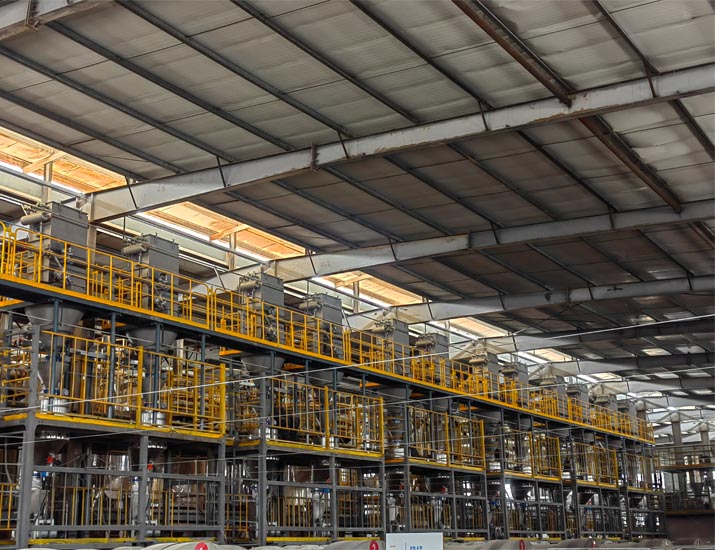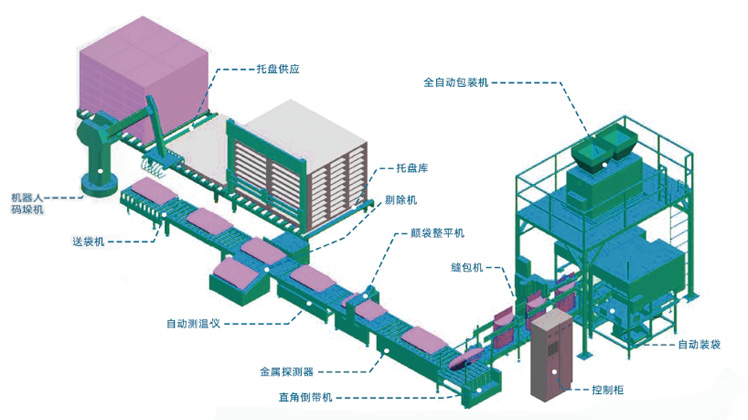We specialize in the development, manufacturing, and implementation of comprehensive systems for the storage, conveyance, measurement, and uniform mixing of powders and granules.

Process Overview for Material Handling Systems
Technical Consultation: Providing expert and practical advice tailored to the customers' process engineering and production demands.
Scheme Planning: Crafting the most optimal and suitable intelligent solutions according to the clients' specific requirements.
System Design: Developing systems grounded in principles of efficiency, rationality, reliability, and eco-friendly energy usage.
Product Development: Creating products that meet customer process needs, focusing on design, functionality, efficiency, cost, ergonomics, and safety.
Manufacturing and Processing: Equipped with advanced processing capabilities and comprehensive assembly skills, supported by an experienced quality control team.
Project Implementation: Rich experience in project management and the capacity to execute turnkey projects.
After-sales Service: Offering ongoing, upgradeable system services and comprehensive life cycle management for products.
Company's Core Advantages
The company boasts its own equipment processing center.
The center is fully equipped with modern equipment for lifting, machining, sheet metal riveting and welding, surface treatment, and heat treatment.
Conducts performance tests on materials to evaluate their processability.
Product Components
The material handling system consists of six integrated subsystems:
Dust Removal System: For material gas-solid separation, dust filtration, and recovery within the system.
Unpacking System: Designed for unpacking and feeding from bags, equipped with a dust removal system to maintain a slightly negative pressure during the process, preventing dust escape.
Storage System: Utilized for material storage and buffering, adaptable to different flow assistance methods depending on material characteristics. Compatible with level switches, temperature sensors, pressure sensors, or weighing systems.
Conveyance System
Weighing System: Enables automatic measurement and batching of powder and granular materials, achieving high-speed, precise weighing and feeding.
Control System: Tailored to fulfill production requirements and customer-specific process needs.
Development and application of products have led to high-quality, unmanned packaging and palletizing production lines. High standards for product research and development, benchmarking against leading international brands, have been established. A highly qualified R&D team with a well-structured disciplinary background possesses complete mastery of key technologies in industrial automation, including mechanical system structures, servo systems, and software control systems. Custom development of non-standard equipment is offered.
Fully Automatic Packaging Machine Production Line

Pallet Supply
Pallet Library
Rejector
Bag Flattening Machine
Sewing Machine
Control Cabinet
Automatic Bagging
Fully Automatic Packaging Machine
Fully Automatic Weighing Unit
Fully Automatic Electronic Quantitative Scale
Fully Automatic Packaging Unit
Bag Supply to Bagging 一> Clamping Mouth一 > Folding 一> Sealing Bag
Automatic Conveying and Inspection Unit
Metal Detection一 > Weight Recheck一 > Sorting
Fully Automatic Palletizing Unit
Conveying 一> Flattening一 > Repositioning一 > Grouping Push Bag Press Bag 一> Layering 一> Lifting 一> Pallet and Pallet Conveying
Equipment Introduction:
Column Palletizer:The column robot is widely utilized in industries that handle bagged, barreled, and boxed packaging, for palletizing and transporting tasks. This equipment utilizes a robotic control system to achieve direct line interpolation from point to point, resulting in smooth and fluid movement. The teaching pendant facilitates the control of the industrial robot’s movements through key controls and display functions, enabling operators to easily perform teaching control of the manipulator's movements. Pallet patterns are pre-stored and can be flexibly operated; during work, the robot completes the stacking of bagged products according to the preset grouping method and layer count.
Robot Palletizer:The palletizing robot is a specialized, integrated industrial device used for stacking bags in predetermined groupings layer by layer onto pallets or into containers. Commonly employed as a subsequent device in packaging lines, it enhances production and transportation capabilities.
Technical Parameters:The high-position palletizer is an automated, well-integrated, efficient palletizing equipment. It arranges bags in predetermined patterns and stacks each layer onto pallets. Typically functioning as a follow-up to packaging lines, it boosts production and logistics capabilities.
No Bucket Packaging Machine:This equipment utilizes high-precision sensors and intelligent weighing controllers for automatic bag count and weight statistics, with automatic correction for deviations. Contact parts with materials are made of stainless steel to meet food hygiene standards, are corrosion-resistant, and prolong the equipment's life. The setup comprises a feeding device, a weigh-belt conveyor, an automatic thread-cutting sewing machine, and an adjustable height conveyor.
Single Bucket / Suit Single Bucket Packaging Machine :These machines cater to different customer needs with pneumatic and servo-electric feeding methods. The differences lie in packaging speed and single-bag accuracy. The servo motor feeder packaging machine is equipped with a full touchscreen weighing instrument for simpler and smarter operation.
Double Bucket Packaging Machine :This equipment features dual-bucket measurement, consisting of A and B weighing buckets. The system automatically controls the alternating cycle of weighing and discharging, effectively utilizing space for improved efficiency. It incorporates advanced control technology, sampling processing technology, and anti-interference technology for automatic error compensation and correction.
Belt Packaging Machine:The Belt Quantitative Packaging Machine uses advanced microcomputer control instruments, automatic fault diagnosis, and is constructed with stainless steel in all parts that contact materials. It is suitable for flaky, mixed, and high-moisture materials, and is widely used in chemical, fertilizer, food, friction material, and refractory industries.
Double-Station Belt Packaging Machine:The double-station belt quantitative packaging machine features a fast dual-station design and uses advanced microcomputer control instruments for automatic fault diagnosis. It is suitable for flaky, mixed, and high-moisture materials and used extensively in chemical, fertilizer, food, friction material, and refractory industries.
Spiral Packaging Machine:The Powder Packaging Machine is a new high-performance packaging machine that overcomes challenges caused by large variations in material dryness and moisture, including slow packaging speed, material sticking, and surge issues. It is suitable for packaging powdered materials in industries like flour, starch, feed, food, chemicals, light industry, and pharmaceuticals.
Double-Station Spiral Packaging Machine:This packaging machine can perform tasks such as metering, bag clamping, filling, sealing, sewing, and conveying. The metallic parts of the machine are painted, enhancing wear and corrosion resistance. It can pack 200 to 350 bags per hour and is designed for materials with poor flowability. All parts that contact materials are made of stainless steel.
Ton Bag Packaging Machine:This equipment uses different feeding forms (such as DC, screw, vibration, belt) for material loading based on different materials. It offers stable performance, high packaging accuracy and speed. The weighing system uses high precision sensors, with comprehensive panel digital tuning and parameter setting, featuring cumulative weight display, automatic tare, zero correction, high sensitivity, and strong anti-interference capability.
Semi-Automatic Packaging Machine:The Semi-Automatic Bagging Machine requires manual bag placement, with other tasks completed automatically. The sewing system includes automatic bag clamping, standing bag conveying, mouth shaping, mouth conveying, sewing, etc. The entire semi-automatic sewing machine system is controlled by an independent PLC + touch screen control system. It features protective stops and emergency stop functions.
Fully Automatic Packaging Machine:This equipment mainly completes the processes of material weighing, automatic bagging, packaging, edge folding sealing, and output in an automated manner, saving labor, material, and financial resources. It reduces production costs and improves efficiency for clients, widely applicable in various industries for packaging granular, powdered, and mixed materials.
In the realm of digital factories and workshop visualization, complemented by collective equipment procurement, our enterprise excels in:
Enterprise-level RFID Applications: Development and implementation of sophisticated automated storage control systems.
Industrial Inspection Hardware: Pioneering research and production of industrial inspection hardware products.
Finite Element Analysis
Industrial Design: With nearly a decade of expertise in the enterprise measurement and control field, our company has evolved from individual project expertise to a comprehensive platform breakthrough. Our self-developed data acquisition platform is now successfully deployed for our corporate clients.。
Unified Platform:The essence of Industry 4.0 lies in the Cyber-Physical System (CPS) or Information-Physical System.
Dual Network Integration:Industry 4.0 integrates products, machinery, resources, and personnel through "Internet of Things" and "Internet of Services."
Dual Strategy Implementation:Embracing "Market Leadership Strategy" and "Supplier Leadership Strategy" to establish dominance in market and supply sectors.
Three Critical Integrations:Determining the Success of the Dual Strategy:
1.Horizontal integration through the value network.
2.End-to-end digital integration across the entire value chain.
3.Vertical integration and networked manufacturing systems.
Digital Engineering Components of Automated Storage Systems::
1.Intelligent Storage System.
2.Intelligent Robots for process circulation.
3.Intelligent Sorting System.
4.Intelligent Picking System.
5.Intelligent Loading and Unloading Systems.
Application Scenarios:Specializing in the intelligent integration of discrete equipment across machines for unified control and management.
| Interface Types | Typical Applications | Remarks |
|---|---|---|
| Input Points | Production counting, equipment switch monitoring. | |
| Output Points | Machine start authorization, equipment alarm systems. | |
| Analog Inputs | Field sensor data collection | voltage signals, current signals |